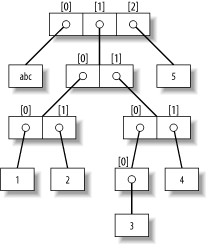| [ Team LiB ] |
|
7.4 Object GeneralityWe've seen a number of compound object types (collections with components). In general:
Because they support arbitrary structures, Python's compound object types are good at representing complex information in a program. For example, values in dictionaries may be lists, which may contain tuples, which may contain dictionaries, and so on—as deeply nested as needed to model the data to be processed. Here's an example of nesting. The following interaction defines a tree of nested compound sequence objects, shown in Figure 7-1. To access its components, you may include as many index operations as required. Python evaluates the indexes from left to right, and fetches a reference to a more deeply nested object at each step. Figure 7-1 may be a pathologically complicated data structure, but it illustrates the syntax used to access nested objects in general: >>> L = ['abc', [(1, 2), ([3], 4)], 5] >>> L[1] [(1, 2), ([3], 4)] >>> L[1][1] ([3], 4) >>> L[1][1][0] [3] >>> L[1][1][0][0] 3 Figure 7-1. A nested object tree |
| [ Team LiB ] |
|